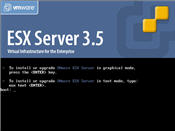Hardcore virtualization - VMware ESX 3.5/Infrastructure - Part 1

This will be my first in a series (an "X = X +1" sort of series) where I'll be looking at virtualization. However, rather than look at the kind of virtualization where you install an OS like Windows, Mac OS or Linux and then install an application that allows you to create virtual machines, I'm going to be looking at virtualization at a much lower level using VMware's ESX 3.5 and Infrastructure applications. I'm going to start off by looking at VMware ESX and taking you through the install process.
Note: I'm not going to pretend that this has broad appeal for home users, because it doesn't. While products such as VMware Player, Microsoft Virtual PC and even VMware's excellent Workstation and Fusion (for the Mac OS) products has bought virtualization to the masses (or at least made it accessible), products like VMware ESX 3.5 and Infrastructure fall into the business/enterprise category and prices range from $495 for ESXi to "if you got to ask the price, it's not for you" for Infrastructure Enterprise.
VMware ESX 3.5
VMware ESX 3.5 is a bare metal hypervisor. This means that you have a very minimal OS and application layer installed directly onto the hardware that you want to virtualize, and this allows you to partition the system (a server) into multiple virtual machines. These virtual machines can have differing configurations and are free to run side by side.
OK, so you might be wondering what the advantages are of VMware ESX over the Workstation product. Well, all the benefits come down to not needing to install and administer the base OS that would be required to install the desktop virtualization application. This means that ESX offers:
- A dramatically smaller hardware footprint, so more system resources available to virtualized systems
- Less system administration
- Lower cost (thanks to a variety of reasons)
- Easier backup and restoration of systems
Setup
Installing ESX 3.5, contrary to what a lot of people think, is pretty easy. You need the installation media (60-day evaluation available here), a system to install it onto, and about 20 minutes.
Note: To take the following screenshots I installed VMware ESX 3.5 onto a VMware Workstation virtual PC (yes, a bare metal hypervisor installed onto a virtual system). Unfortunately, you can't do a direct install and you do need jig about with the configuration files. The good news is that xtravirthave created a set of clear instructions showing how to do this.
If it's your first time installing ESX 3.5 then I suggest that you carry out the install in graphical mode like I did here. However, once you've done a few installs you're likely to be ready to progress to the text mode setup.
The installation is wizard driven and very easy - probably the most taxing part is the network configuration (and that's only if you're not using DHCP).
Stay tuned for more ...
Thoughts?
